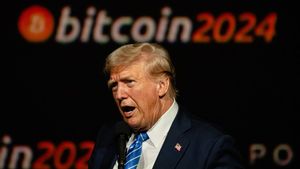JAKARTA - Currently the COVID-19 pandemic is not only worrying about public health, but also the business sector in the field of cellphone sales. The impact of the virus has significantly hit the world smartphone market.
According to a report on the market share website CounterPoint, Monday, May 11, since the first quarter of this year, overall smartphone sales have been below 300 million units. This is the lowest sales figure, since 2014.
In fact, if there was no pandemic, the signs of a recovery in the smartphone market would have occurred at the end of the fourth quarter of 2019. However, now global sales of smartphones since the beginning of 2020 have not even reached more than 295 million units.
This is a relatively low figure, when compared to the previous year's period, which could reach 341 million units. This decline was also influenced by the reduction in the number of global shipments by 27 percent Year Over Year (YoY) in China. At that time, China became the global epicenter of this pandemic.
So the overall revenue from China's share of the global smartphone market in Q1 2020 has decreased dramatically from 26 percent last year to 22 percent today. This decline also had an impact on the sales of handsets and components for several Original Equipment Manufacturers (OEMs), which in the future will affect global shipments.
However, at the end of the quarter when the COVID-19 outbreak began to spread around the world, and the lockdown policy was implemented, the decline in sales began to recover from supply to demand.
“From a consumer point of view, except for replacing a damaged cell phone, a smartphone is largely a discretionary purchase. Consumers, under these uncertain times, are likely to hold back from making many significant discretionary purchases. This means that the replacement cycle tends to be longer, "said Associate Director at Counterpoint Research, Tarun Pathak.
The continuing effects of the pandemic on the smartphone market are likely to be even worse in the second quarter. This is because in China the market has recovered, while other than the Bamboo Curtain country is still experiencing a lockdown. Because this depends on the severity of the spread of the virus.

Recovery in some of these markets may also take longer. Going forward, brands with a larger share in China, such as Huawei, are in a better position than brands such as Samsung, where nearly all of its major markets are in lockdown.
It is known that Samsung led the smartphone market during the Q1 2020 quarter, which had a fifth of global smartphone shipments. OEMs declined 18% YoY during the quarter and are expected to see a steeper decline in Q2 2020.
Huawei continued to follow its path and added a push in China that surpassed Apple again during the quarter. Although its OEMs decreased 17% year on year during the quarter. More than half of current shipments of Huawei smartphones are in China.
Nothing beats Apple, it remained resilient even during COVID-19 as iPhone shipments decreased by only 5% YoY during the quarter. Although this was accompanied by an estimated 7% YoY decline in iPhone revenue for the same period. The impact on several European and Asian countries is in the category of harmless.
Another Chinese brand, Xiaomi, grew by approximately 7% year on year during the quarter. OEMs continue to lead the Indian smartphone market achieving the highest market share of 30 percent since Q1 2018.
Compared to other major OEMs, Vivo declined by a whopping 10% YoY during the quarter. The strong performance in the Indian Smartphone Market partly offsets declines in other markets. Others, despite the declining global smartphone shipments, Realme's global market share in Q1 2020 reached 2 percent but remained stable at number 7 in the global smartphone vendor.
The English, Chinese, Japanese, Arabic, and French versions are automatically generated by the AI. So there may still be inaccuracies in translating, please always see Indonesian as our main language. (system supported by DigitalSiber.id)








